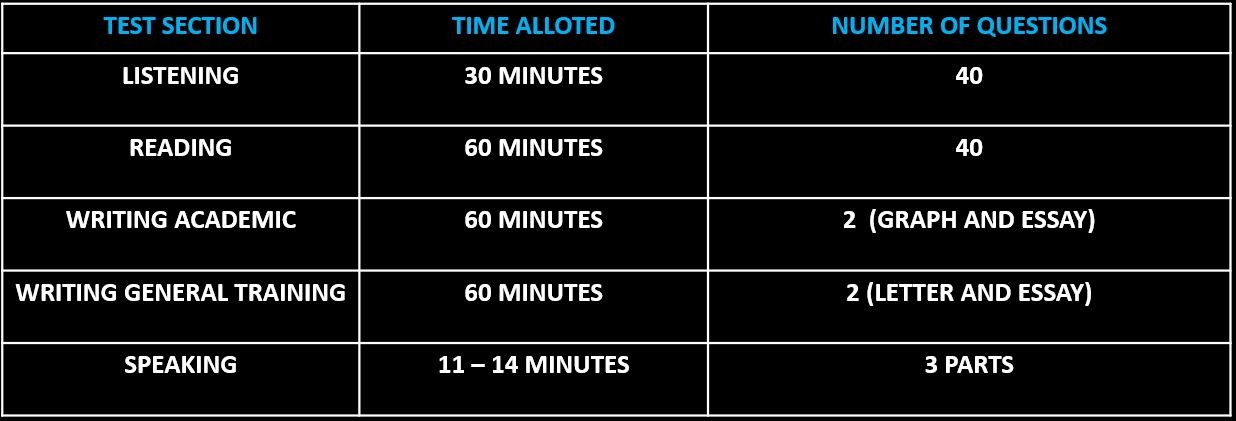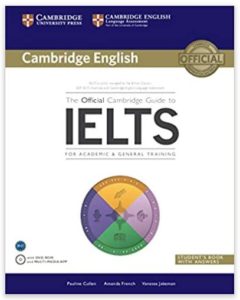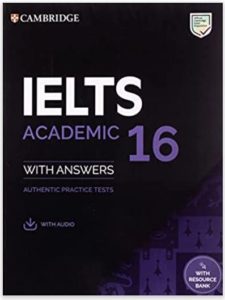Everything You Need To Know About IELTS (Complete Guide)
Everything You Need To Know About the IELTS in 2023 (A Complete Guide)
Are you looking to study work or immigrate to a native English speaking country?
You may be required to take the IELTS test. First step towards this journey is learning about the test.
The internet is filled with fragmented information about the IELTS.Trying to make sense of this information can be overwhelming for new test takers.
To save you from having to go through this pain, I’ve put together this blog post explaining everything you need to know about the test, all in one place.
Here’s what you will learn –
- What is the IELTS test?
- Who is the test for?
- How much does it cost?
- Test types, versions and formats.
- Scoring Scale.
- How to prepare for the test?
1. WHAT IS THE IELTS TEST?
IELTS is a standardized test designed to assess English language proficiency for non-native speakers.
Standardized tests are tests that are conducted and graded consistently. In other words, on any given day, the questions asked, time allotted and grading criteria are the same for all students taking the test.
IELTS stands for International English Language Testing System. It is owned and operated in partnership by 3 educational and learning institutes – IDP Australia, Cambridge Assessment English and the British Council.
The IELTS tests your ability to – listen, read, write and speak English.
Listening and reading are considered receptive skills, since you are being assessed on your ability to passively comprehend the language.
While speaking and writing are considered productive skills, since you are actively using the language to demonstrate your abilities.
2. WHO IS THE IELTS TEST FOR?
If you are looking to study, work or immigrate to native English-speaking countries like US, UK, Canada, New Zealand and Australia, you may be required to take the IELTS test.
Being able to demonstrate your English language proficiency proves your ability to easily integrate into native English-speaking communities and be successful at school or work.
If you are reading this post, you have more than likely established your need to take the IELTS test.
If you are unsure, you can determine your need to take the test by visiting websites of the university, organization or immigration body of the country you aspire moving to.
3. HOW MUCH DOES IT COST TO TAKE THE IELTS TEST?
The cost of IELTS test varies by country and test center. Depending on where you take your test it may cost you anywhere between 150 to 300 USD.
To check how much it will cost you to take the IELTS at your preferred test center visit www.ielts.org/for-test-takers/book-a-test or contact the test center directly.
As of April 2022, taking the IELTS in the United States will cost you approximately 250 USD on average at most locations. The cost is the same for both General Training and Academic test types discussed below.
In India the IELTS will cost you approximately 15,500 INR at most test locations.
4a. IELTS TEST TYPES
There are two types of IELTS test –
- Academic IELTS
- General Training IELTS
Academic IELTS is required by higher education bodies like universities as an acceptance criterion for different programs. If you are a student seeking admission into universities in native English-speaking countries, Academic IELTS is for you.
General Training IELTS is mainly required by Immigration bodies as an eligibility criterion for immigration programs. If you are an aspiring immigrant General Training IELTS is for you.
Some employers also require General Training IELTS scores for foreign workers to prove their English language proficiency.
For both Academic and General Training tests, once taken, scores are valid for 2 years from the date of the test result and you can send your scores to up to five organizations for free.
4b. TEST VERSIONS
The IELTS test is offered in two versions –
• Paper based &
• Computer based
In the Paper based version, you are provided with question booklets, answer sheets and pencils to record your answers for the listening, reading and writing sections of the test.
The question booklets and answer sheets are distributed by the supervisor at the beginning of each section. You are not allowed to open the question booklets until instructed by the supervisor.
In the Computer based version you will type your answers directly into the computer for listening, reading and writing sections.
For the listening sections, headphones will be provided by the test center.
The speaking test for both paper and computer-based versions is conducted as an in-person interview with an examiner.
4c. TEST FORMAT
The listening and speaking tests for both Academic and General Training exams are the same. While reading and writing tests are different.
The total duration of the test spans about 2 hours 45 minutes.
Listening, reading and writing tests are taken in one sitting spanning 2 hours 30 minutes.
The speaking test lasts for about 11-15 minutes and can either be taken on the day of the test, a week before, or a week after the other three tests.
Here are more details on the format each test –
Listening
- The listening test lasts 30 minutes and consists of 40 questions across 4 sections.
- On each section you are asked to listen to a recording and write your answers on the question booklet provided (paper-based test). The recording will only be played once and will not be repeated.
- You will be given an additional 10 minutes at the end of the test to transfer your answers to the answer sheet.
- For the computer-based test, you are required to type in the answers directly into the computer as you listen to the recording.
- You will NOT be given the additional 10 minutes at the end of the test, as you are not required to transfer your answers to an answer sheet.
- However, you will be given 2 minutes at the end of the test to check your answers.
Reading – Academic
- Academic reading test consists of a variety of texts that are descriptive, factual, and analytical in nature and may contain graphs, charts or diagrams for interpretation.
- Based on these texts, you are asked to answer a total of 40 questions.
- Texts are selected from newspapers, books, and journals.
Reading – General Training
- The reading test for the General Training exam has three sections and a total of 40 questions to answer.
- The first section has two to three short texts, second section has two short texts that are work related, and the third section has a long text on a common topic of interest. The texts are chosen from books, magazines, newspaper articles, company handbooks, etc. and are generally easier than texts seen on the academic reading test.
Writing – Academic
- Academic writing test consists of two tasks. You are allotted a total of 60 minutes to complete both tasks.
- In Task 1, you are asked to write a summary of at least 150 words describing a graph, chart, or diagram given.
- Writing Task 1 accounts for only 33% of your total writing score and it recommended that you spend no longer than 20 minutes on this section. However, it is totally up to you to manage your time between the two sections.
- On Task 2 you are asked to write a formal essay, at least 250 words long of on a given topic. It accounts for 66% of your total writing score and it is recommended that you spend at least 40 minutes on this task.
Writing – General Training
- In Writing task 1 you are asked to write a letter of at least 150 words in response to a given situation.
- In the letter you may be asked to extend an invitation to a friend, complain to an authority, ask a colleague for help on a project, etc.
- Writing task 1 is allotted only 33% of the total writing score and you are advised to spend no more than 20 minutes on it.
- Writing task 2 on General Training is same as the Academic IELTS. You are asked to write an essay of at least 250 words on a given topic.
Speaking
- The speaking test for Academic and General Training IELTS is conducted as an in-person interview with a certified IELTS examiner.
- It lasts for 11-15 minutes and consists of 3 parts.
- Part 1 begins as a general introduction between the examiner and yourself. The examiner will introduce themselves and ask you to do the same to confirm your identity, after which you will be asked simple follow up questions on everyday topics like family, work, hobbies, interests, etc.
- In Part 2 you will be asked to talk for 1-2 minutes on a topic handed to you on a task card. The task card will describe the topic and give you some points you need to cover in your talk. You will be given 1 minute to prepare your talk and a scratch-pad and pencil to make notes. Once time is up, the examiner will ask you to start talking and will not interrupt you for the duration of your talk. It is important that you continue talking until asked to stop by the examiner. The examiner will then ask you one or two questions on the same topic to conclude part 2.
- In Part 3 the examiner will proceed to ask more questions on the topic given in part 2. The questions are intended to test your ability to form opinions and discuss more abstract ideas in detail.
The below table summarizes the number of questions and time allotted on each test section.

5. SCORING SCALE
All 4 sections (i.e. listening, reading, writing and speaking) on the IELTS test are graded on a Band scale of 0-9, in increments of half band scores, and a combined overall band score is awarded. I’ll talk more about how overall band scores are calculated below.
Higher band scores represent higher skill level of the test taker. For example: band 9 represents an expert user, band 8 represents a very good user, band 7 represents a good user and so on.
The below table summarizes the skill level represent by each band score –


Calculating overall band score –
Overall band score is calculated by taking the average of band scores on each section and rounding to the nearest half or whole band score.
For example, if your band scores on each section are as follows – Listening 8, Reading 7.5, Writing 6.5, Speaking 7, your overall band score is calculated as (8+7+6.5+7)/4 = 7.125 rounded to the nearest whole band score of 7.0
Similarly an average band score of 7.25 across all sections is rounded to an overall band score of 7.5, 7.75 is rounded to 8 and so on.
6. HOW TO PREPARE FOR THE IELTS TEST?
Now that you know enough about the test, let us discuss how to prepare for it, by answering the most commonly asked question –
Can I prepare for the IETLS test at home ?
The simple answer is Yes. There are plenty of books and resources available online to help you prepare for the IELTS from the comfort of your home.
At the same time, there is also a lot of misinformation and poor advice floating around the internet, that can confuse and mislead test takers.
IELTS is an expensive test and you should plan to spend a good amount of time on preparation and practice before actually taking it.
It is not uncommon for test takers to repeat the test 3 or more times to achieve their target band scores as a result of poor preparation and falling prey to misinformation online.
The best way to avoid this is to only refer to official practice material published by IELTS and seek advice from experienced IELTS trainers.
The following Official IELTS books from Cambridge English contain authentic IELTS practice tests and are great reference books for test takers –
In addition to these books there are several free official IELTS practice questions and tests available online. Here are some useful links to free official IELTS material –
- Free IELTS practice tests published by British Council
- Sample IELTS questions on ielts.org website
- Free practice tests and material by IDP Australia
Success in the IELTS exam boils down to 5 main things –
- Having appropriate level of English to achieve your target band score
- Familiarity with test format and question types
- Understanding the way you are assessed
- Time management &
- Sufficient practice under test conditions
Knowing this, here’s what you need to do prepare –
Get an accurate assessment of your current skills
The first step in preparing for your IELTS test is to get an accurate assessment of your current English language skills.
You can get a good estimate of your current listening and reading skills by attempting IELTS practice tests for these sections.
For writing and speaking sections however, you will need to get help from an experienced IELTS trainer or examiner.
Set an achievable target band score
Once you know where you stand, the next step is to set an achievable target band score. In order to do that, you need to understand what it means to achieve that band score and if your current level of English is sufficient.
Higher the gap between your current level of English and the level of English needed to achieve your target band score, the more time and effort you will need.
Learning IELTS test skills is easy, improving your English is not. Expect to put in several months of focused effort to improve your English to a level required by a whole band or more.
It is therefore important to set realistic goals and timelines to achieve them.
I will cover tips and strategies to improve your English in future posts on this website.
Familiarize yourself with the test format and question types
Before you even think of attempting the test, you need to spend time familiarizing yourself with the format and question types on each test section.
Each test section has several different question types. In order to be successful, you not only need to be familiar with each of these but also have the right strategies prepared to tackle them in the allotted time.
Practice under test conditions
Once you have familiarized yourself with test format, question types and learned the right skills and strategies to tackle them, the next step is to attempt the full practice test under exam conditions.
On test day you will be required to sit for over 2.5 hours at a stretch. This can both physically and mentally taxing, if you are not used to it.
Time management is critical. It is important that you get comfortable with the pace of the exam before entering the test center.
Conclusion
In order to be successful in your IELTS test, you need to know where you stand with your current level of English, set a realistic target band score, familiarize yourself with the test format and question types, learn tips and strategies to tackle each question type and practice under test conditions


Hey there! Welcome to Datum IELTS. I’m Prem, the owner and operator of this website.
I’m an Industrial Engineer by profession and a teacher at heart. I run this website with my wife Keerti, who is also an engineer and shares my love of teaching.
We are both experienced IELTS trainers with native English proficiency, teaching IELTS for the past 4 years. We created this website to serve millions of students who take the IELTS every year.
Most of the content on our website is FREE, and we do our best to share the most up-to-date and accurate information on IELTS preparation. Feel free to look around. Happy learning!
Table of contents
7 steps to a band 7 IELTS Score
Affiliate disclosure
Our website is supported by our readers. We sometimes earn commissions from purchases made by clicking links posted on this website. This post contains affiliate links. We encourage you to read our full affiliate disclosure here.
Privacy Policy Terms & Conditions Disclaimer
Copyright © 2022 Datum IELTS Academy
Everything You Need To Know About IELTS (Complete Guide) Read More »


